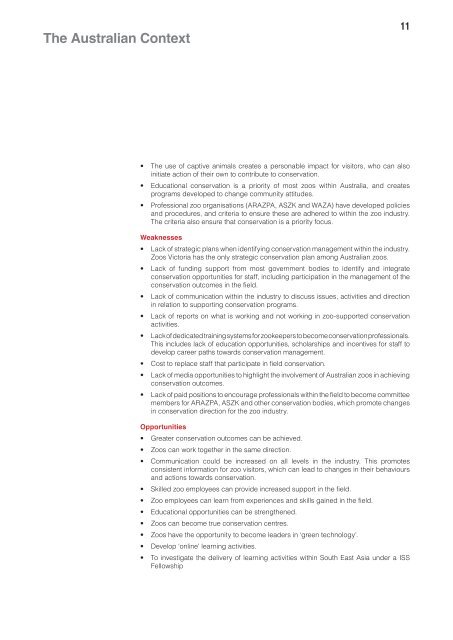Indonesian Conservation Management Practices & the Australian ...
Indonesian Conservation Management Practices & the Australian ...
Indonesian Conservation Management Practices & the Australian ...
- No tags were found...
You also want an ePaper? Increase the reach of your titles
YUMPU automatically turns print PDFs into web optimized ePapers that Google loves.
The <strong>Australian</strong> Context11• The use of captive animals creates a personable impact for visitors, who can alsoinitiate action of <strong>the</strong>ir own to contribute to conservation.• Educational conservation is a priority of most zoos within Australia, and createsprograms developed to change community attitudes.• Professional zoo organisations (ARAZPA, ASZK and WAZA) have developed policiesand procedures, and criteria to ensure <strong>the</strong>se are adhered to within <strong>the</strong> zoo industry.The criteria also ensure that conservation is a priority focus.Weaknesses• Lack of strategic plans when identifying conservation management within <strong>the</strong> industry.Zoos Victoria has <strong>the</strong> only strategic conservation plan among <strong>Australian</strong> zoos.• Lack of funding support from most government bodies to identify and integrateconservation opportunities for staff, including participation in <strong>the</strong> management of <strong>the</strong>conservation outcomes in <strong>the</strong> field.• Lack of communication within <strong>the</strong> industry to discuss issues, activities and directionin relation to supporting conservation programs.• Lack of reports on what is working and not working in zoo-supported conservationactivities.• Lack of dedicated training systems for zookeepers to become conservation professionals.This includes lack of education opportunities, scholarships and incentives for staff todevelop career paths towards conservation management.• Cost to replace staff that participate in field conservation.• Lack of media opportunities to highlight <strong>the</strong> involvement of <strong>Australian</strong> zoos in achievingconservation outcomes.• Lack of paid positions to encourage professionals within <strong>the</strong> field to become committeemembers for ARAZPA, ASZK and o<strong>the</strong>r conservation bodies, which promote changesin conservation direction for <strong>the</strong> zoo industry.Opportunities• Greater conservation outcomes can be achieved.• Zoos can work toge<strong>the</strong>r in <strong>the</strong> same direction.• Communication could be increased on all levels in <strong>the</strong> industry. This promotesconsistent information for zoo visitors, which can lead to changes in <strong>the</strong>ir behavioursand actions towards conservation.• Skilled zoo employees can provide increased support in <strong>the</strong> field.• Zoo employees can learn from experiences and skills gained in <strong>the</strong> field.• Educational opportunities can be streng<strong>the</strong>ned.• Zoos can become true conservation centres.• Zoos have <strong>the</strong> opportunity to become leaders in ‘green technology’.• Develop ‘online’ learning activities.• To investigate <strong>the</strong> delivery of learning activities within South East Asia under a ISSFellowship

















